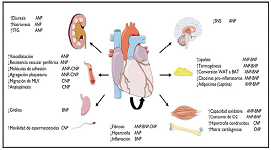
Asia Pacific Academy of Science Pte. Ltd. (APACSCI) specializes in international journal publishing. APACSCI adopts the open access publishing model and provides an important communication bridge for academic groups whose interest fields include engineering, technology, medicine, computer, mathematics, agriculture and forestry, and environment.

Effects of optimized left atrioventricular conduction time on hemodynamics and prognosis in patients with third degree atrioventricular block implanted with dual chamber pacemakers
Vol 2, Issue 2, 2021
Download PDF
Abstract
Objective: To investigate the effect of optimized left atrioventricular conduction time (Lavi) on hemodynamics and prognosis of patients with third degree atrioventricular block implanted with dual chamber pacemakers. Methods: 120 patients with third degree atrioventricular block implanted with dual chamber pacemaker were randomly divided into Lavi optimized group and non optimized group. Oesophageal electrocardiography was performed 3 months after pacemaker implantation (observation base point). The atrial conduction time (IACT) and interventricular conduction time (IVCT) of the two groups were measured and the Lavi under the default atrioventricular delay (AVD) state of the pacemaker was calculated. The optimization group then adjusted the AVD of the pacemaker under the guidance of echocardiography to obtain the optimal Lavi under the best mechanical synchronization state of the left atrioventricular. All patients were examined by echocardiography at 6, 12 and 18 months after operation. ECG conduction parameters, related clinical manifestations and prognostic indicators were observed, and the relationship between optimal Lavi and heart rate was analyzed. Results: a) In the optimization group, the average optimal Lavi was (130.8 ± 11.9) ms, which was longer than the default Lavi value (120.7 ± 18.7ms) (p < 0.05). b) In the optimization group, the optimal Lavi was negatively correlated with heart rate (r = −0.955, p < 0.05), heart rate <70 beats/min, and the optimal Lavi was 140 ms; the heart rate was 70~80 beats/min, and the optimal Lavi was 130ms; heart rate >80 beats/min, and the optimal Lavi is 120 ms. c). Optimization of Lavi could immediately improve e-peak deceleration time (EDT) and isovolumic relaxation time (IVRT) in the optimization group (p < 0.05). d) The left ventricular ejection fraction (LVEF), EDT and IVRT of the optimized group were better than those of the non optimized group at 6 months after operation (p < 0.05), and the left atrial volume index and e/e ‘(the ratio of early diastolic flow velocity of mitral orifice to early diastolic movement velocity of mitral annulus) were better than those of the non optimized group at 12 months after operation (p < 0.05). e) LVEF and EDT in the non optimized group decreased gradually during the follow-up period of 18 months (p < 0.05); IVRT and left atrial volume index increased gradually during the whole follow-up period (p < 0.05). E/e ‘in the optimization group increased gradually during the follow-up period (p < 0.05), while EDT decreased gradually during the follow-up period (p < 0.05). f) The cumulative incidence of new paroxysmal atrial fibrillation in the optimization group was significantly lower than that in the non optimization group (8.3% vs. 23.3%, p < 0.05). Conclusion optimization of Lavi can improve hemodynamics and reduce the incidence of atrial fibrillation in patients with third degree atrioventricular block implanted with dual chamber pacemakers.
Keywords
References
- Zheng L, Du X. Ventricular Pacing on the Prognosis of Patients with Pacemaker Implantation. Cell Biochemistry and Biophysics. 2013; 69(2): 225-228. doi: 10.1007/s12013-013-9786-2
- Lu D, Zhang H, Zhang H. Cardiac resynchronization therapy improves left ventricular remodeling and function compared with right ventricular pacing in patients with atrioventricular block. Heart Failure Reviews. 2018; 23(6): 919-926. doi: 10.1007/s10741-018-9722-z
- Guo J. Left atrioventricular interval (Continued). Journal of Clinical Electrocardiology. 2008; 17(06): 456.
- Xu Y, Li Z, Yang X. Noninvasive cardiac electrophysiological diagnosis and treatment technology-basic and clinical. Beijing: Peking University Medical Press; 2017. pp. 71-75.
- Klimczak A, Chudzik M, Zielińska M, et al. Optimization of atrio-ventricular delay in patients with dual-chamber pacemaker. International Journal of Cardiology. 2010; 141(3): 222-226. doi: 10.1016/j.ijcard.2009.10.021
- Guo J. Left atrioventricular interval. Journal of Clinical Electrocardiology. 2008; 17(05): 382.
- Miki Y, Ishikawa T, Matsushita K, et al. Novel Method of Predicting the Optimal Atrioventricular Delay in Patients with Complete AV Block, Normal Left Ventricular Function and an Implanted DDD Pacemaker. Circulation Journal. 2009; 73(4): 654-657. doi: 10.1253/circj.cj-08-0351
- Maria CP, Fabio F, Nicola M, et al. A Perspective on Atrioventricular Delay Optimization in Patients with a Dual Chamber Pacemaker. Pacing and Clinical Electrophysiology. 2004; 27(3): 333-338. doi: 10.1111/j.1540-8159.2004.00437.x
- Zhou Z, Chen M, Du Z. Effect of pacemaker automation on cardiac function in elderly patients. Chinese Journal of Geriatric Cardiovascular and Cerebrovascular Diseases. 2015; 17(10): 1094
Supporting Agencies
Copyright (c) 2021 Shulan Zhang, Jiaqi Qiang, Qingxiong Yue, Linan Li, Peishi Yan, Jing Dong, Jie Qiao, Hailong Lin

This work is licensed under a Creative Commons Attribution 4.0 International License.

This site is licensed under a Creative Commons Attribution 4.0 International License (CC BY 4.0).

Prof. Prakash Deedwania
University of California,
San Francisco, United States




